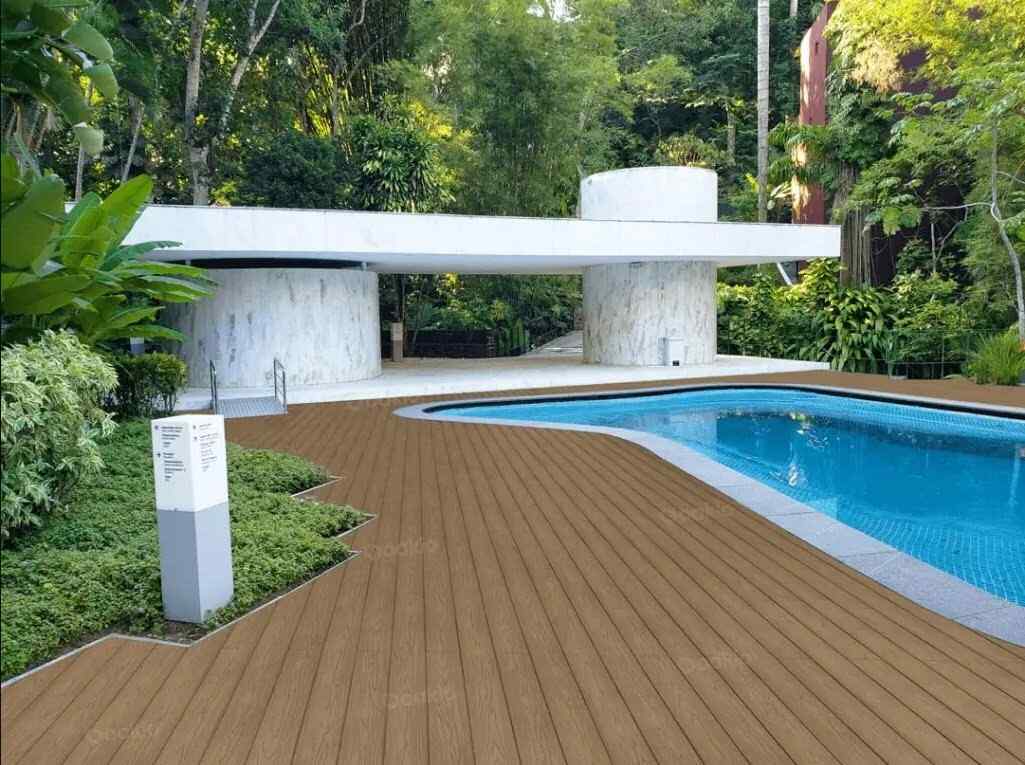Nobody wants to spend their weekends sanding, staining, or fixing warped boards when building a deck. That’s why I’m a big fan of composite decking—it’s the ultimate low-maintenance solution. Unlike traditional wood, it’s designed to look great for years without all the hassle.
What is Composite Decking?
Composite decking is a manufactured material made by combining wood fibers and plastic. It replicates the appearance of natural wood while offering greater durability and reduced maintenance demands.
Definition and Composition
Composite decking typically contains 50-60% wood fibers and 40-50% recycled plastic bonded with chemical additives. This blend creates a sturdy, weather-resistant surface that doesn’t splinter, warp, or fade as quickly as wood. The boards are available in various colors and finishes, mimicking the texture of real wood.
I remember installing composite decking in my yard. Its smooth finish was slip-resistant, and the prefinished boards saved me hours of painting.
Comparison to Traditional Wood Decking
Unlike wood, composite decking doesn’t require sanding, sealing, or staining. It resists mold, pests, and moisture damage, which extends its lifespan. Traditional wood, while beautiful, needs regular care to prevent rotting and cracking.
Cost-wise, composite decking has a higher upfront price. But, long-term savings from reduced maintenance make it more budget-friendly overall. This durability convinced me to choose it over regular hardwood for my deck.
Why Composite Decking is a Low-Maintenance Choice?
Composite decking resists common issues like rot, fading, and warping better than wood. It’s made to handle weather extremes without frequent repairs. I’ve rarely needed to clean my deck—a quick rinse a few times a year keeps it looking new.
Unlike wood, composite boards don’t require sanding or staining for upkeep. They’re pest-resistant, eliminating concerns about termites or other damage. The consistent color and texture also mean no worrying about repainting or replacing uneven boards.
Many composite decking brands include warranties highlighting their low-maintenance benefits, making it an investment for those who value time-saving outdoor solutions.
Types of Composite Decking
|
Type of Composite Decking |
Description |
|
Capped vs. Uncapped Composite Decking |
Capped composite decking has a protective outer layer that resists moisture and staining. Uncapped decking is more affordable but requires extra maintenance. |
|
Solid vs. Hollow Boards |
Solid boards mimic traditional wood and are durable for heavy use. Hollow boards are lighter and budget-friendly but less sturdy. |
|
Material Variants |
Wood-plastic composites blend wood fibers with recycled plastic for aesthetics and durability. Fully plastic decking resists water and rot, making it ideal for wet environments. |
|
Color and Texture Options |
Composite decking comes in various colors, from earthy tones to modern grays. Textured finishes enhance slip resistance and visual appeal. |
Benefits of Composite Decking
Low Maintenance Requirements
Composite decking needs minimal upkeep compared to traditional wood. Cleaning involves occasional rinsing with water and soap rather than yearly sanding or sealing. Since it resists rot, mold, and insects, there’s no worry about repairing damaged boards. For me, skipping the hassle of constant refinishing made enjoying my deck even more satisfying.
Durability and Longevity
Compared to wood, composite decking lasts longer. It stands up to weather extremes, resists warping, and doesn’t splinter over time. The material’s combination of recycled plastic and wood fibers ensures durability, with some boards lasting over 25 years. Its resilience means you’re not frequently replacing damaged planks, saving time and effort.
Aesthetic Appeal
Composite decking offers a realistic wood look with consistent finishes. Boards come in various colors and textures that match different styles. I chose a natural-looking grain texture that complemented my home’s design and stayed vibrant even after exposure to sunlight and rain. The appearance doesn’t fade, keeping outdoor spaces visually appealing for years.
Environmental Sustainability
Using composite decking supports recycling efforts. Most boards are made from 40-50% recycled plastics and wood fibers, reducing reliance on virgin materials. Opting for this decking decreases waste and environmental damage compared to traditional wood harvesting. It’s a practical choice for anyone aiming to reduce their carbon footprint.
Cost Considerations
While initial costs are higher, composite decking saves money over time. The absence of sanding, sealing, and staining lowers long-term maintenance expenses. For example, I noticed significant savings within a few years. Paired with minimal repair needs, the upfront investment easily pays off in reduced upkeep costs.
Conclusion
I installed composite decking on my patio five years ago, and it still looks brand new with minimal effort. A quick rinse and occasional scrub keep it clean, and I’ve never dealt with fading, warping, or splinters. Unlike my old wooden deck, its durability saves me from constant repairs.
Composite decking is the best choice because it is low maintenance, resistant to weather, and long-lasting. Its wood-like appearance adds aesthetic value without the hassle of staining or sealing. Composite decking is hard to beat for anyone valuing time and long-term savings.

